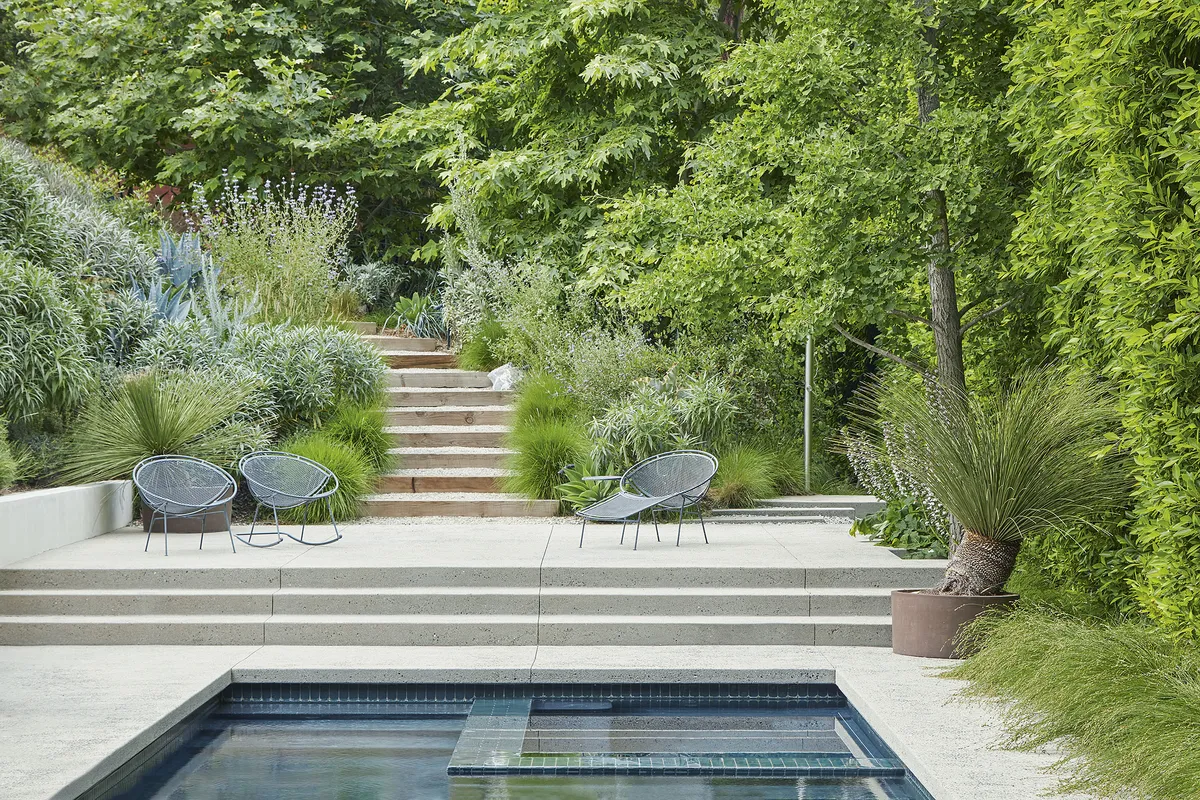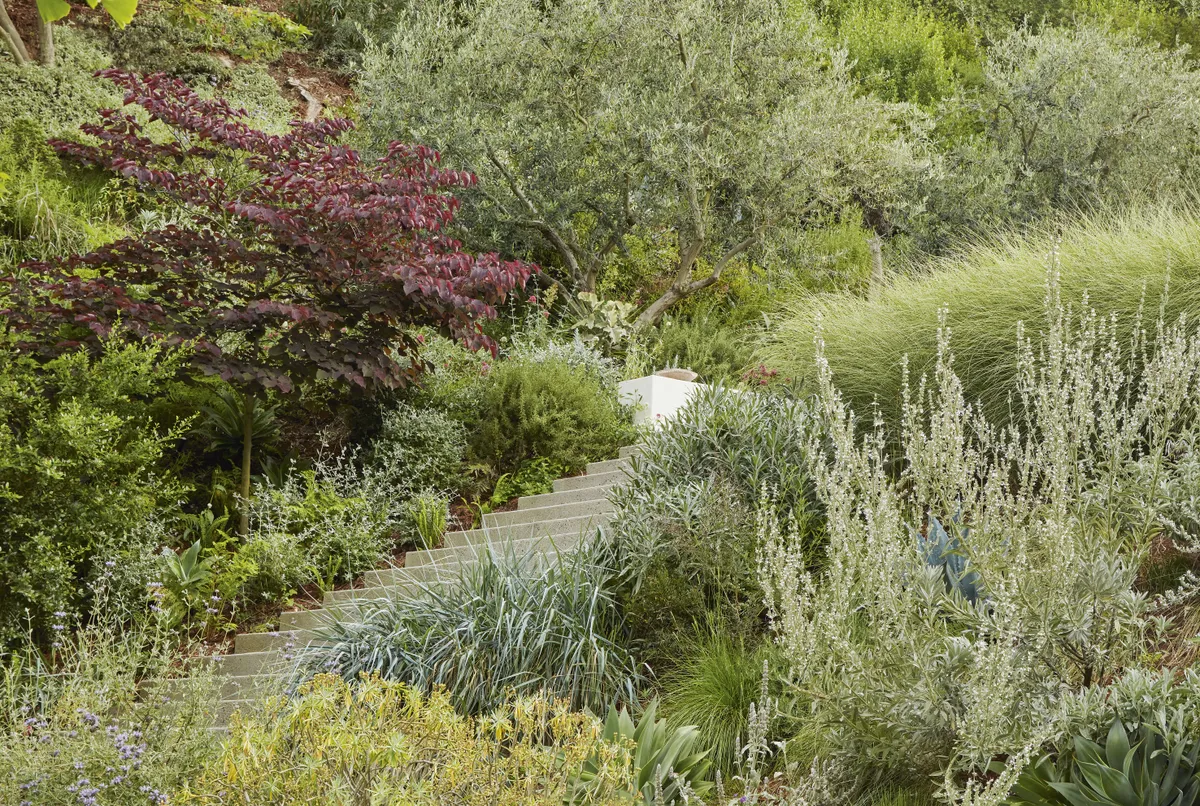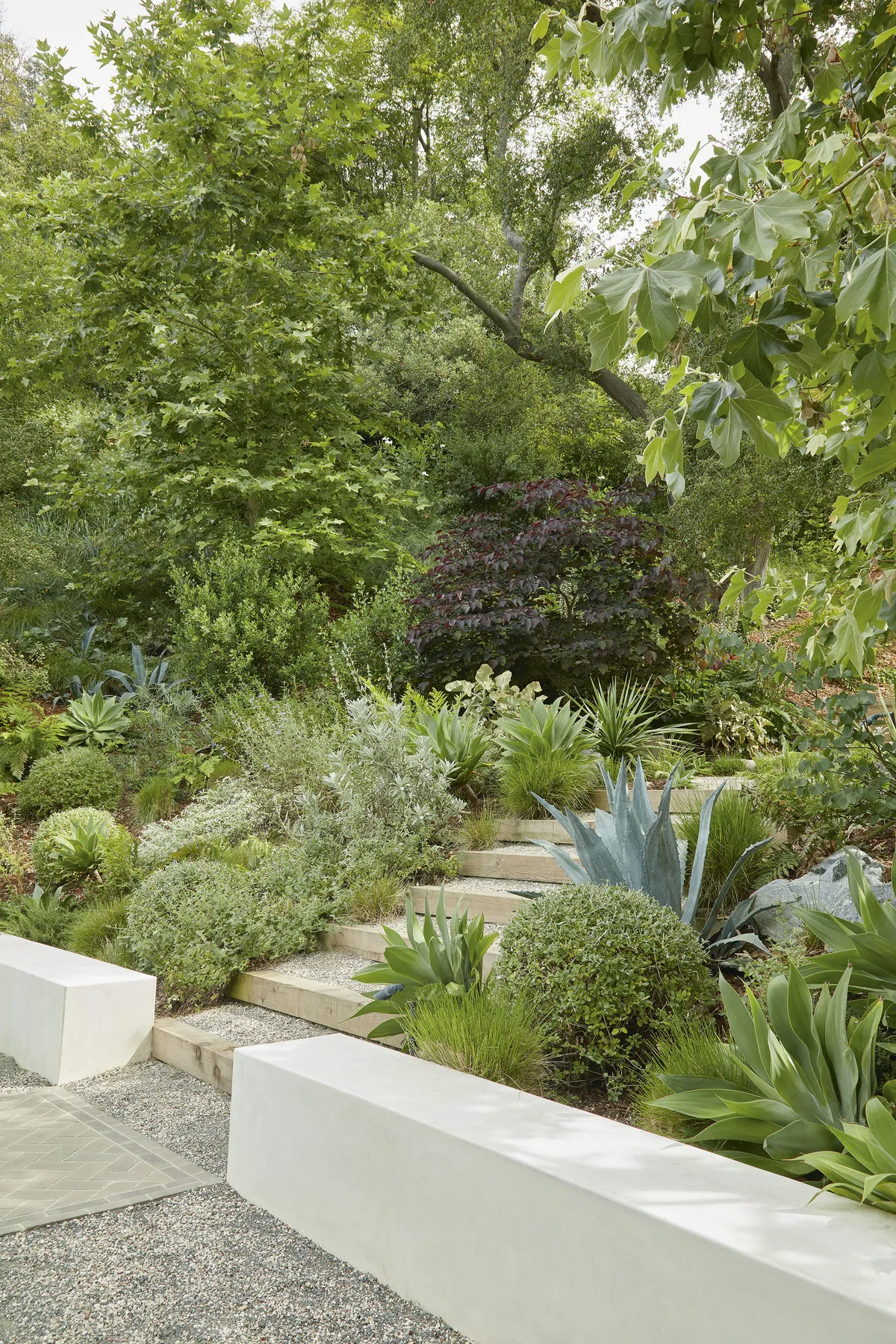In Brief
What A steep, private garden surrounding a post-modern, Californian house. Where Los Angeles. Size Three-quarters of an acre. Soil Sandy, free-draining loam. Climate Dry, subtropical, cool in winter and spring. Hardiness zone USDA 10.

Manicured and private are two words that come to mind when thinking of Bel Air, the prosperous neighbourhood on the west side of Los Angeles. Basking in the foothills of the Santa Monica mountains, Bel Air – as the name implies – is fresher and cooler than the urban valleys, including Hollywood and Downtown. Up here, reminders of the native landscape of Southern California are more apparent, with venerable trees, hill-covering chaparral (evergreen shrub communities) and coastal sage scrub. The wilderness of LA’s more sedate neighbourhoods is generally upstaged, however, by green lawns and palm trees, of which only one species (Washingtonia filifera) is native to California.
This fairly large garden, hidden away on a side street, sits in a peaceful zone between nature and people. It is surrounded by California sycamores (Platanus racemosa) and coastal live oaks (Quercus agrifolias), several of which reside on the property, having been there long before the post-modern house was built. “How one goes about ‘garden-making’ around these sentient trees was a primary concern of the project,” recalls David Godshall of Terremoto, the West Coast’s most engaging landscape design studio. At seven years old, Terremoto has been attracting interesting projects from its earliest days, including the Getty Museum – and this – a collaboration with ultra-chic interior designers and architects Studio Shamshiri, which the studio began in 2016.

David, who heads the LA office (his co-partner Alain Peauroi is based in San Francisco), loves construction and carpentry (he is a former retail designer) and there is a flourish in Terremoto’s use of hard materials. A deck is never just a deck; here, it connects to a boardwalk set flush against grass and then gravel, these textural horizontals reacting with the smooth, perpendicular planes of the house. It is a showcase for specimen trees, shrubs and succulents, before plant life tumbles down the hillside in a more disordered throng. Terremoto – more of a collective than two principals and staff – has a keen appreciation of boulders, and a fondness for agaves, particularly Agave attenuata along with scatterings of toothed A. americana.
“We use agaves because they’re strong, structural elements that can act as aesthetic exclamation points or asterisks, within landscapes of texture, or fields,” says David. “They’re tough, don’t complain, and can provide a sense of lushness in what is actually a very low-water landscape.”

This brings us, inevitably, to the subject of lawns and pools. An irregular quadrilateral of grass, its geometry reinforced by a line of box, comprises the most formal part of the garden. “Lawns in California are a dangerous topic,” says David. “We infrequently grant them to people under two conditions: one, that they are scaled appropriately and two, that they are used. Small, thoughtfully sized lawns that people use regularly are acceptable in our book.”
Swimming pools, in Terremoto’s hands, are not about ostentation either: this one is removed from the house, and sits serenely at the bottom of a ravine. “We like to surround pools with hardscape that has texture and personality,” says David, who is not a great fan of infinity edges. “We’d rather wrap a pool in planting, so that when you swim, you’re surrounded by vegetation.”
Around the pool, further sunken by gracefully wide steps, all is smooth underfoot, Carex divulsa flopping along one side, and a well-placed Mexican grass tree (Dasylirion longissimum) spilling out of a pot. Between the pool and the house is what David best describes as “a wild, textural, native hillside of sage and lavender” that is stopped dead in its tracks at the top by the formal box hedge. The native hillside is mainly made up of three endemic sages, Southern California’s coastal scrub: Salvia apiana, S. clevelandii and S. mellifera. Around some narrower steps, which make possible a quick dash from pool to dining area with bare feet, the mostly green-and-silver planting is enhanced by Cercis canadensis ‘Forest Pansy’, “the shade of a booming Cabernet”. The main set of steps down to the pool by the front of the house mixes more sage with rounds of Lolium mairei from Morocco and Echium fastuosum from Madeira.

With its hot, dry summers and cool, wet winters, California has been identified as having a ‘Mediterranean’ climate. Mediterranean plants thrive here; as a term, however, it is used for describing five regions in the world that are considered biodiversity hotspots. Sharing a similar latitude and occurring on the western edges of continents, these regions are glorious for plants but also fatally attractive to humans. Terremoto (Spanish for earthquake) is keen to “softly” push people in the direction of native ecology, instead of clobbering them over the head with it. “In this project you see dribs and drabs of various typologies dancing together,” says David. “There are Mediterranean moments, desert and cactus moments, nods towards the new perennial movement – all the while being pulled together with California natives.”
Notions of beauty need to change, he says, and there are signs that they are changing. The Terremoto manifesto (which makes compelling reading) describes the firm’s approach as ‘critically regionalist and respectfully inflammatory’ but also ‘post-internet’. With all its downsides, David explains, the constant sharing of information has had a liberating effect, so that people are no longer held hostage to what is in and what is out. “Everything is there for the taking; you just have to do it well."
USEFUL INFORMATION
Find out more about Terremoto’s work at terremoto.la